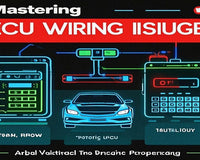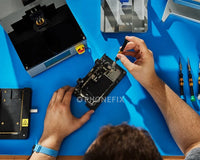Modern vehicles rely heavily on complex onboard electronic systems. Car chips as the core driving force, the importance of automotive chips is self-evident. A traditional fuel car needs to be equipped with about 500-600 chips. With the advancement of the "new four modernizations" of automobiles, the number of chips carried by new energy vehicles has climbed to about 1,000, and the number of chips in highly intelligent new energy vehicles has exceeded 2,000. However, a seemingly minor chips, it can trigger a cascade of malfunctions. 
What kind of vehicle system failures will be caused by cold chip welding?
Symptoms like a blacked-out car navigation screen, unresponsive window controls, or erratic dashboard warning lights often stem from poor connections between chips and circuit boards. This problem is particularly acute in high-temperature areas, such as modules near the engine compartment, where thermal stress exacerbates solder joint weaknesses. Traditional direct soldering of replacement chips risks further damaging the motherboard due to repeated heating. So, how can automotive technicians address this challenge effectively?
The IC socket replacement method offers a practical and efficient solution. Instead of directly soldering new chips onto the circuit board, technicians first remove the faulty chip and then solder a compatible IC socket onto the exposed pads. When choosing an IC socket, it's crucial to match the socket's pin count to that of the chip, such as 20Pin or 40Pin variants. Once the socket is securely soldered, the new chip can be safely inserted, providing a stable connection. This approach minimizes the risk of overheating the motherboard during multiple soldering operations, making it ideal for repairs and future maintenance.
Essential Tools for Effective Repairs.
Having the right tools is key to successful chip and IC socket repairs. A high-quality soldering iron with precise temperature control is essential for removing old chips and soldering IC sockets without causing damage. Additionally, a desoldering pump or wick helps clean the pads thoroughly before installing the socket. For tasks that require greater precision, hot air rework stations can be used to remove and install surface-mount components. Magnifying glasses or digital microscopes are also invaluable for inspecting tiny solder joints and ensuring proper connections.
While the IC socket method reduces soldering risks, other challenges remain. If the chip itself is damaged, such as an ECU control chip suffering from a short circuit, simply replacing the socket won't solve the problem. In these cases, the chip must be replaced, and its underlying driver programs rewritten using a ECU programmer. Failure to update the software can lead to compatibility issues, potentially causing new malfunctions or rendering the vehicle's electronic systems inoperable. Technicians must also take precautions to avoid electrostatic discharge (ESD), which can damage sensitive chips. 
Chip cold soldering is a common but solvable problem in automotive electronics. By using the right methods and repair tools, technicians can efficiently diagnose and repair vehicle system failures. As vehicles become more digital, mastering these repair techniques is essential to ensure the reliability and safety of modern transportation systems.
Is Cold Soldering of Chips Causing Vehicle System Failures?










